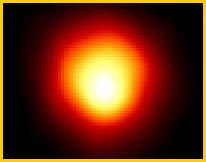|
Suddenly
One Night
The pattern of stars in the night sky usually looks the same from
night to night and from year to year. But every century or so, a
new star appears suddenly one night and then fades back to invisibility
over the next few months. Such a star is called a "nova"
(from Latin for "new"). As astronomers learned about the
true nature of stars, they realized that novae were exploding stars.
Some novae were fairly bright--reaching a few hundred thousand times
the brightness of the Sun. Other novae were incredibly bright--reaching
several billion times the brightness of the Sun! These amazingly
bright novae were renamed "super"-novae.
The drawing
at the top of the page shows the transfer of matter from one star
to another in a binary system. The "normal" star (lower
left corner of the drawing) has expanded until the gravitational
pull on its surface by the small, bright partner--a white dwarf--is
equal to its own gravity. This allows gas to "leak" away
from the normal star onto a disk of material around the white dwarf.
The material in the disk spirals inward and collects on the surface
of the dwarf until it collapses to form a Type I supernova. Illustration
courtesy of STScI.
There
are two main types of supernova. The first,
called Type I, occurs when a burnt-out
star called a white dwarf orbits around
a large star. Gas from the large star
collects onto the white dwarf, increasing
its mass and surface gravity. If the gravity
on the white dwarf becomes strong enough,
the dwarf becomes unstable and collapses,
releasing huge amounts of energy. Part
of the mass of the collapsing dwarf is
blasted outward as a supernova explosion
cloud while the rest falls inward to form
a "black hole."
The second type
of supernova, called Type II, occurs when a star greater than about
8 times the mass of our Sun runs out of nuclear "fuel."
The star's core collapses in a fraction of a second and releases
huge amounts of energy and sub-atomic particles. Part of the core
and the outer layers of the star are blasted outward in an explosion
cloud, and the rest of the core collapses inward to form a black
hole or a neutron star.
 This
image of Betelgeuse taken by the Hubble Space Telescope is the first
image of the disk of a star other than our Sun. Betelgeuse is a
red supergiant star over 1,000 times larger than the Sun and 10
to 20 times as massive. Someday in the not too distant future, Betelgeuse
will explode as a Type II supernova. Photo
courtesy of STScI. This
image of Betelgeuse taken by the Hubble Space Telescope is the first
image of the disk of a star other than our Sun. Betelgeuse is a
red supergiant star over 1,000 times larger than the Sun and 10
to 20 times as massive. Someday in the not too distant future, Betelgeuse
will explode as a Type II supernova. Photo
courtesy of STScI.
Back | Next
|











